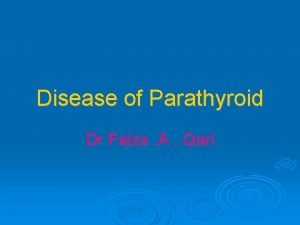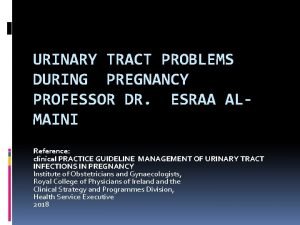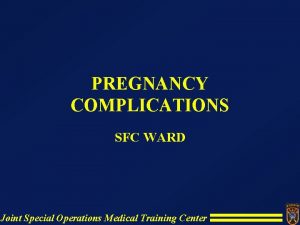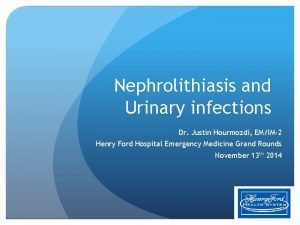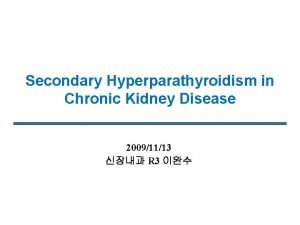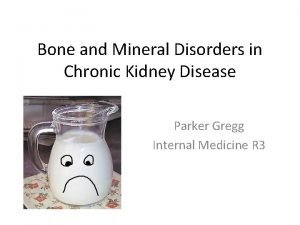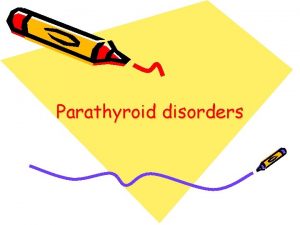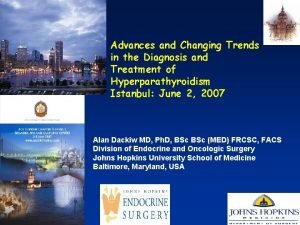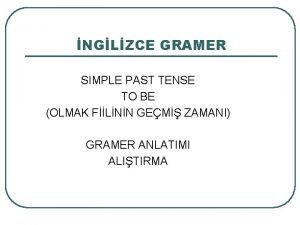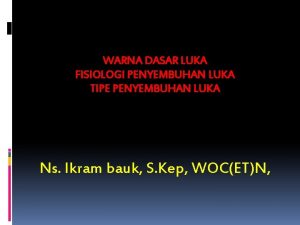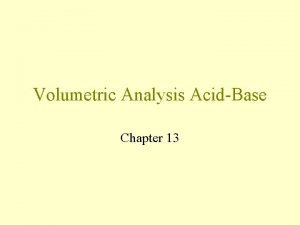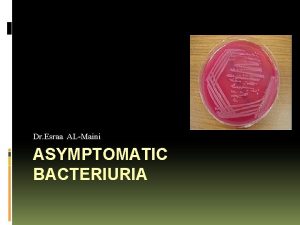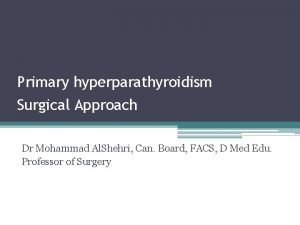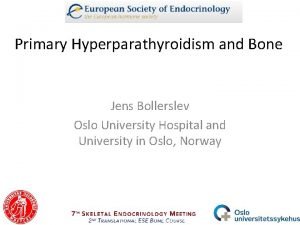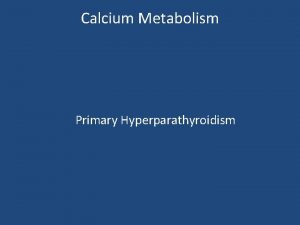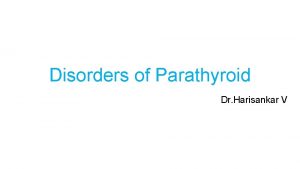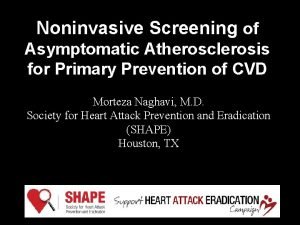Presentation of Asymptomatic Primary Hyperparathyroidism 1 Is there


























































- Slides: 58


Presentation of Asymptomatic Primary Hyperparathyroidism

1. Is there new information on the natural history of PHPT? 2. Are there data to support the need for geographyspecific guidelines for disease management? 3. What are the new data regarding the effects of PHPT on its two classical target organs: the skeleton? 4. And the kidney? 5. Are there new insights on non classical manifestations of PHPT, namely those affecting the cardiovascular system? 6. And neuropsychiatric/cognitive function? 7. Do new data on changes in serum calcium levels, renal function, or bone involvement (bone mineral density [BMD] and fragility fractures) over time suggest new guidelines for surgery?


Presentation and Natural History Asymptomatic PHPT dominant clinical phenotype of PHP (USA/EU) Nephrolithiasis most common overt complication , skeletal involvement detected by (DXA), lumbar spine BMD is relatively well preserved whereas the distal 1/3 radius is preferentially reduced Natural history : long-term, but not indefinite, stability and increases in BMD at all sites by DXA, after successful parathyroidectomy (PTX) Over the past 10 years, emergence of normocalcemic PHPT (NPHPT) USA

Confunded data about epidemiology of NPHPT due to different method for exclution of 2 ry HPT There have been very limited new data adding to the literature on the presentation of this variant of PHP Need for research on the effect of NPHPT on classical and nonclassical target organs of the hyperparathyroid process

Question 1: Does new information about the natural history of asymptomatic PHPT (both hypercalcemic and normocalcemic) help to determine when surgical therapy is appropriate in each variant of the Disease Response: No. There is no new information on the natural history of PHPT that clarifies when surgical therapy is appropriate in either hypercalcemic or normocalcemic variants of the disease Although many physicians are approaching management decisions in NPHPT in a manner similar to asymptomatic PHPT, evidence-based guidelines are lacking

Geographic Differences in the Clinical. Presentation In a study in Southern California (covering 3. 5 million enrollees) , the incidence of PHPT varied from 34 – 120 per 100 000 person-years, with a mean of 66 per 100 000 person -years in women, and from 13 to 36 per 100 000 personyears in men. The incidence increased with advancing age, and was highest in blacks, followed by whites, with rates for Asians, Hispanics, and other races lower than for whites The prevalence of PHPT tripled during the study period (1995– 2010),

Europe A recent retrospective cross-sectional study in two Caucasian populations (US and Italian) of men and women: despite similar levels of circulating PTH, Italian patients have more pronounced effects of the disease, with higher serum calcium and lower BMD Latin America most Latin American patients still present with symptomatic disease Evolution toward more asymptomatic disease . A study of 4207 patients in brazil a prevalence of 0. 78% , of which 81. 8% were asymptomatic. Osteitis fibrosa cystica was present in 6. 1%, nephrolithiasis in 18. 2%, and acute neuropsychiatric syndrome in 3%, with 51. 5% having fatigue and 39. 3% having muscle weakness

ASIA china : asymptomatic cases increased from less than 20% before 2006 to approximately 50% in 2007– 2010. ( serum calcium testing/thyroid US). In Hong Kong, asymptomatic PHPT increased from 5% in 1973– 1982 to 39% in 1983– 1992 to 59% in 1993– 2002 other Asian countries (India, Iran, Saudi Arabia, Thailand) still report predominantly symptomatic disease , and asymptomatic PHPT is rare (0 – 2. 2%). Normocalcemic PHPT has not yet been formally described in Asian cohort

Question 2: Should regional geographic differences in the clinical presentation of PHPT lead to regional differences in surgical guidelines? Response: Not yet , the disease is changing from a high rate of symptomatic disease toward a large number of asymptomatic patients. In some countries where data are available, the normocalcemic variant is becoming more common. However, it is unclear that thes data warrant regional differences in surgical guidelines.

Classical Features—The Skeleton BMD in asymptomatic PHP DXA is a standard of care for the evaluation of PHPT. Determine the advisability of surgery in asymptomatic patients monitor patients over time. bone loss is greatest at the forearm (33% radius), {cortical bone} least at the lumbar spine, {trabecular bone} Successful PTX increases in BMD that are greatest and most rapid at the lumbar spine and hip, followed later by increases in the distal 1/3 radius. A meta-analysis : increases in BMD are similar with surgery and antiresorptive therapy. Cinacalcet reduces the elevated serum calcium to normal in most subjects but does not improve BMD

Bone turnover markers in PHPT Half of patients with PHPT have increased bone turnover markers. In the absence of intervention, markers tend to be stable for years Parathyroidectomy results in a normalization of bone markers. higher preoperative markers associated with greater postoperative increases in BMD Estrogen therapy and raloxifene and alendronate reduce bone turnover markers. Cinacalcet therapy lowering PTH levels but not BTM

The bone biopsy in PHPT By dynamic parameters, bone turnover is increased in PHPT. Microstructural abnormalities are predominantly seen in cortical bone (reduced cortical width and increased porosity), whereas the trabecular compartment is relatively well preserved. High-resolution imaging DXA is the “gold standard” in the evaluation of any metabolic bone disease. Areal quantity (g/cm 2), not a true bone density (g/cm 3). Quantitative computed tomography measures true volumetric BMD (mg/cm 3 ), and can distinguish between cortical and trabecular bone

HRPQCT Estimate bone strength/FX risk/assess age related bone loss/ pharmacological treatment for osteoporesis The results are more compatible with fracture incidence data than the results obtained by DXA or by the bone biopsy. Unfortunately, HRp. QCT is available in only a few sites in the world and is unlikely to become widely used

Trabecular bone score (TBS) Direct measures of bone microarchitecture and fracture risk and can differentiate between bone structures with the same a. BMD but different trabecular micro-architecture. TBS analysis by lumbar spine DXA image. Enhance the ability of DXA to discriminate those with and without fractures and to predict osteoporotic fractures, independent of a. BMD TBS data are also compatible with epidemiological evidence of increased fracture risk at vertebral and nonvertebral sites in PHPT

Fracture risk in PHPT Studies limited by their retrospective design, small sample size, selection of patients and controls, and variable definitions of vertebral fractures Although antiresorptive drugs increased BMD in placebocontrolled trials, no data are available on whether these agents reduce fracture risk in PHPT Overall, increased risk of fractures in PHPT. The risk of forearm fractures is increased, whereas PHPT. does not seem to be common in patients with hip fracture. Variable results on the risk of vertebral fractures

3 A. Do the new data on the skeletal manifestations of PHPT support a re-examination of skeletal criteria for surgery? Response: Yes. Assessment using DXA and the transiliac bone biopsy may not accurately reflect the quality or strength of trabecular bone in PHPT, whereas cortical bone HRp. QCT are consistent with DXA and abnormalities by bone BX. As TBS becomes more widely available, TBS used with DXA may become a reasonable option.

3 B. Do the new data warrant a change in guidelines for monitoring with or without parathyroid surgery? Response: No. New data show improvement in BMD after surgery, and early data with HRp. QCT and TBS also confirm postoperative improvements in skeletal microstructure. Therefore, there does not appear to be any reason to change the guidelines for monitoring with or without parathyroid surgery

3 C. Should there be a change in the densitometric threshold for surgery? Response: Not at this time lumbar spine DXA gives information that is inconsistent with central vertebral fracture risk in PHPT. Abnormalities are noted both by HRp. QCT and by TBS, even when the spine DXA is normal With greater availability of TBS, perhaps both should be used together to determine a densitometric threshold for surgery

3 D. Should bone density at the lumbar spine, hip, and distal radius sites be viewed differently with regard to recommendations for surgery? Response: Perhaps. Lumbar spine DXA value is overestimating bone strength whereas the distal 1/3 radius value is likely to be consistent with microarchitectural studies. (Importance of the 1/3 radius measurement in PHP) 3 E. Is there a role for FRAX or other fracture risk assessment tools in assessing fracture risk in patients with PHPT, and should this be included in the recommendations for surgery? Response: Not yet It is not clear whether FRAX would predict fractures in the same way in PHPT that it does in individuals without PHPT.

Classical Features—The Kidney Most likely to demonstrate clinically overt complications of PHPT (nephrolithiasis or nephrocalcinosis)/ regulate calcium and phosphate Calcium stone disease most common manifestation of PHPT, (15 and 20% ). About 3% of patients with stone disease have PHPT, and about 10% of patients with PHPT present with recurrent calcium stone disease. In more severe forms , mineralization in the kidney tissue diagnosed radiographically as nephrocalcinosis. However, Randall’s plaques, small deposits of calcium phosphate in the renal papillae are common, not seen radiologically important in the pathogenesis in urinary calcium stone formation and nephrocalcinosis

Are there new data on the renal manifestations of PHPT (stones, urinary calcium excretion, renal function)? Should the new data, if they exist, change recommendations for surgery based upon these renal manifestations? Response: Yes. Current renal imaging modalities underestimate the amount of calcification present Improved methods are required we recommend renal imaging for subclinical stone disease or nephrocalcinosis. (Renal ultrasound, abdominal x-ray, and spiral CT scan of the kidneys) Positive imaging shall constitute an indication for surgery. we recommend that risk factors for stone formation be assessed, Finally, above average fluid intake should be stressed for all PHPT patients followed without surgery.

Nonclassical Features—Cardiovascular 5 A: Should evaluation of PHPT include assessment for cardiovascular abnormalities? Response: No. 5 B: Should cardiovascular manifestations be considered in decisions regarding surgery? Response: No There are no prospective data on cardiovascular outcomes in asymptomatic PHPT. The carotid bed more affected than the heart, with elevated carotid IMT an Increased plaque thickness, Cardiac structure was mostly normal / propagation of vascular calcification. Closer association of some cardiovascular indices (left ventricular mass, CFR, carotid stiffness, and aortic plaque area) with PTH as opposed to calcium. RCTdata no benefit of surgery with regard to markers of the metabolic syndrome, including hypertension, cholesterol, inflammatory markers, adipokines, and other cardiovascular risk markers.

Nonclassical features—neuropsychiatric and cognitive. Should neuropsychiatric and cognitive dysfunction be considered in decisions about surgery for PHPT? Response: No. PHPT is associated with neuropsychological dysfunction includng depression, reduced QOL, and changes in cognition. Cognitive dysfunction may related to the presence of depression. Data regarding improvement in neuropsychological symptoms and cognitive function after PTX are inconsistent between studies Insufficient evidence of symptom improvement to recommend PTX for neurological or psychological symptoms, although some patients do experience symptomatic improvements after surgery. There also insufficient data to recommend formal neuropsychiatric or neurocognitive testing in PHPT.


In patients with PHPT who are followed without surgery, what represents a clinically significant change in serum calcium, renal function, and BMD that would constitute an indication for surgery? 1) an increase in serum calcium to levels 1 mg/d. L above the upper limit of normal 2)BMD T-score< -2. 5 progressive reduction in BMD that exceeds the LSC and is between-2 and-2. 5, the physician may opt to recommend surgery although guidelines have not been strictly met 3) a reduction in creatinine clearance to <60 m. L/min

Diagnosis of Asymptomatic Primary Hyperparathyroidism Question 1: A, Do third-generation PTH assays perform better clinically than second-generation PTH assays for the diagnosis of PHPT? B, Do we now have optimal reference intervals for serum PTH, and are these intervals based on individuals who are vitamin D replete? Question 2: A, Should we measure 25 -hydroxyvitamin D [25(OH)D] in all patients with suspected PHPT? B, How should the reference ranges for different assays be interpreted? C, What represents the threshold for over-treatment? D, Is it useful to measure 1, 25 dihydroxyvitamin D [1, 25(OH)2 D] in patients with PHPT, and under what circumstances? ,

Diagnosis of Asymptomatic Primary Hyperparathyroidism Question 1: A, Do third-generation PTH assays perform better clinically than second-generation PTH assays for the diagnosis of PHPT? B, Do we now have optimal reference intervals for serum PTH, and are these intervals based on individuals who are vitamin D replete? Question 2: A, Should we measure 25 -hydroxyvitamin D [25(OH)D] in all patients with suspected PHPT? B, How should the reference ranges for different assays be interpreted? C, What represents the threshold for over-treatment? D, Is it useful to measure 1, 25 dihydroxyvitamin D [1, 25(OH)2 D] in patients with PHPT, and under what circumstances? ,

Do third-generation PTH assays perform better clinically than secondgeneration PTH assays for the diagnosis of PHPT? Only four published studies are available all of which preceded the last PHPT workshop Diagnostic sensitivity for PHPT is similar between second- and third-generation PTH assays (Table 1). It is important to have the adequate reference range for each assay to determine whether PTH concentrations are elevated

Do we now have optimal reference intervals for serum PTH, and are these intervals based on individuals who are vitamin D replete? Further studies needed Upper limit of the PTH reference interval is lower in vitamin D-replete. Diagnostic accuracy for PHPT is also improved in a vitamin D-replete. In Fillee et al study, about 12% of subjects with PHPT had PTH concentrations that were within the normal reference range. A larger case series found 8% of subjects with PHPT whose PTH concentrations were within the normal Range Subjects with hypercalcemia and a PTH in the upper range of normal are physiologically not normal Older and less mobile subjects have less suppression of PTH in response to vitamin D repletion

Is normocalcemic hyperparathyroidism a part of the diagnostic spectrum of PHPT? Yes A variant of the traditional hypercalcemic presentation of PHPT: Elevated PTH with normal total and ionized serum calcium in the absence of secondary causes for elevated PTH (eg: low vit. D/CRF/drugs/hypercalciuria/occult malabsotion) An isolated level of PTH above the upper limit of the normal range should be confirmed on at least two further occasions over a period of 3– 6 months. There have been recent reports that between 4 and 10% of patients with PHPT have normal serum calcium but elevated ionized calcium and PTH NPHPT is the first phase of a biphasic disorder that later may become manifest as hypercalcemic PHPT, occasionally being unmasked by the estrogen deficiency of the menopause Prevalence of this disorder is unclear although it may be between 0. 4 and 3. 1%

Measurement of 25(OH)D A, Should measure 25(OH)D in all patients with suspected PHPT? B, How should the reference ranges for different assays be interpreted? C, What represents the threshold for overtreatment? D, Is it useful to measure 1, 25(OH)2 D in patients with PHPT and under what circumstances? vitamin D deficiency was common in PHPT Due to increased rate of metabolic clearance (24 -hydroxylation) induced by 1, 25(OH) 2 D(and possibly PTH) Low concentrations of 25(OH)D are associated with larger parathyroid adenoma size. Low concentrations of 25(OH)D are associated with higher concentrations of PTH and bone turn-over markers & lower BMD/greater LVH. vitamin D repletion has been associated with reduction in PTH concentrations but little effect on mean serum calcium

Conclusions: We recommend that 25(OH)D be measured in all subjects with PHPT. We recommend the cut-points proposed by the IOM of 50 nmol/L for insufficiency and 25 nmol/L for deficiency, but Concentrations 75 nmol/L could be associated with further reductions in PTH concentrations. Cautious replenishment with vitamin D would seem to be prudent in PHPT. No additional information is gained by measuring 1, 25(OH)2 D, so it is not recommended

Genetics of Hypercalcemia and PHPT What is the genetic basis for syndromic and nonsyndromic forms of PHPT? More than 10% of patients with PHPT will have a mutation in one of 11 genes Testing for mutations help to confirm the diagnosis of a syndromic or nonsyndromic form of PHPT, and thereby help in the clinical management and treatment of PHPT patients and their relatives

Syndromic and nonsyndromic forms of PHPT may occur as hereditary (ie, familial) disorders, or they may occur as nonfamilial (ie, sporadic) diseases Syndromic forms of PHPT may occur as part of. MEN syndromes or HPT-jaw tumor. Nonsyndromic forms including: familial isolated HPT & nonfamilial HPT Approximately 10% of patients presenting with nonfamilial (sporadic) PHPT before the age of 45 years may have a germline. MEN 1, CDC 73, or. CASRmutation. FHH 1: autosomal dominant /lifelong elevations of serum calcium with low urinary calcium excretion (urinary CA/CR clearance ratio typically<0. 01)& normal PTH ( CASR mutation)

What is the value of genetic testing in clinical practice? 1) confirmation of the clinical diagnosis so that appropriate screening for associated tumors can be undertaken; 2) implementation of appropriate treatment 3) identification of family members who may be asymptomatic but harbor the mutation and therefore require screening for tumor detection and early/appropriate treatment 4) identification of the 50% of family members who do not harbor the familial germline mutation and can therefore be reassured

clinical approach to gene testing in a patient with hypercalcemia? Fig 2


Genetic testing should use DNA obtained from leukocytes, salivary cells, skin cells, or hair follicles (ie, non-tumor cells). DNA from parathyroid tumors may contain multiple mutations Best clinical practice for such genetic testing should include agreement (ie, informed consent) from the patient and access to genetic counselors The price currently charged (April 2014) in the United Kingdom for the genetic tests included in Figure 3 is US $2100 We conclude that a genetic test is indicated in some patients with PHPT and hypercalcemia who are at high risk of carrying a mutation

Medical Management of Primary Hyperparathyroidism

Considered in patients who meet criteria for surgery but whose physicians do not advise parathyroidectomy because of comorbidities, contraindications to surgery, or prior unsuccessful neck exploration In addition, medical management may be considered in patients who refuse surgery. Patient might benefit from therapy designed to improve BMD, to reduce the serum calcium concentration, or to accomplish both goals. Clear evidence for progression of HPT may occur in up to one-third of patients followed without surgery

Calcium and Vitamin D Supplementation Should the recommendation for calcium intake in patients with PHPT differ from that of the general population? The Nurses’ Health Study: (over 58 000 nurses followed for 22 years) relationship between dietary calcium intake and the development of PHPT. During follow-up, 277 incident cases of PHPT were noted. Increased risk of developing PHPT was shown in those whose intake of calcium was in the lower quintiles. Calcium supplementation was associated with reduced risk of PHPT In an unblinded 1 -year study based on the Tromsø epidemiological study (1994 – 1995) Calcium supplements were associated with a significant decrease in PTH levels and an increase in femoral neck BMD Conclusion: there is no rationale for dietary calcium restriction in patients with asymptomatic PHPT

Do patients with PHPT who are insufficient or deficient in vitamin D benefit from supplementation? How should vitamin deficiency/insufficiency be managed in patients with PHPT? 25 OHD are typically low PHPT. Modest inverse association between serum PTH and 25 OHD levels in asymptomatic PHPT. 25 OHD levels are inversely correlated with parathyroid gland weight. Recommendations: vitamin D repletion : modest reductions in serum PTH levels but the incidence of worsening hypercalcemia and increased urinary calcium excretion emphasize the need to be cautious when repleting vitamin D in PHPT. Monitor serum and urinary calcium excretion when vitamin D is replete in PHPT. Supplemental doses (eg, 600 – 1000 IU cholecalciferol) Goal: increase the serum 25 OHD levels to 50 and up to 75 nmol/L

How effective is estrogen receptor-targeted therapy in postmenopausal women with PHPT? Estrogen therapy in PHPT may reduce bone resorption & Improve BMD. Useful option for those unable or unwilling to proceed with parathyroidectomy, especially in the presence of menopausal symptoms. The Risk benefit ratio must be evaluated in the individual patient with respect to known relative or absolute contraindications to the use of estrogen. The studies of raloxifene in patients with PHPT are too small and short to reach definitive conclusions or make recommendations

What is the efficacy and safety of bisphonate therapy in men and women with PHPT? The randomized controlled trial data have shown a positive effect of alendronate on BMD at the lumbar spine and hip in PHPT. Bone turnover markers decrease with alendronate therapy. Serum calcium remains stable. In subjects whose BMD is low and who are not candidates for parathyroid surgery, alendronate provides skeletal protection and is a medical option. There are currently no fracture data with bisphonate therapy in PHPT

Is therapy with cinacalcet effective and safe in patients with PHPT across the spectrum of serum calcium concentrations? Is it cost-effective?

Cost effectiveness Zanocco et al (61) compared the cost-effectiveness of monitoring, parathyroidectomy, or cinacalcet therapy in a hypothetical 60 -year-old woman with asymptomatic PHPT and no indication for surgery according to the 2002 criteria The cost of cinacalcet intervention was based on a dose of 30 mg twice daily (total cost per year, about $7095). Parathyroidectomy was cost-effective. Monitoring was the least expensive but also least effective option. Cinacalcet therapy would become cost effective if the annual cost would be decreased to less than $221. Cinacalcet approved by the EMA for patients in whom parathyroidectomy is indicated, for calcium levels, but surgery “is not clinically appropriate or contraindicated. FDA-approved indication for cinacalcet in PHPT is for severe hypercalcemia in patients unable to undergo parathyroidectomy

Is therapy with cinacalcet effective in patients with familial PHPT? Ten to 15% of PHPT have an inherited form & multi glandular disease. Familial PHPT is usually treated surgically, but definitive cure is often difficult. According to studies by Falchetti/ Moyes/Filopantri & Sapoaro Cinacalcet is effective in lowering serum calcium in familial PHPT & is an option for patients with persistent or recurrent hypercalcemia after parathyroidectomy. It is not recommended as initial therapy for these patients. Surgery remains the best initial approach for control of PHPT associated with familial syndromes No evidence regarding the safety of cinacalcet on the growth and function of the other nonparathyroid tumors in MEN 1 and MEN 2 A and in HPT-jaw tumor.

Can cinacalcet and bisphonate be combined in patients with PHPT? According to studies by: Faggiano/Cetani/Keutgen combination therapy appears to achieve both calcium-lowering effects of cinacalcet and stabilization of BMD by bisphonate treatment. In subjects with low BMD and serum calcium levels in the range that is appropriate for cinacalcet use, combined therapy could be beneficial

Guidelines for the Management of Asymptomatic Primary Hyperparathyroidism






Patients who do not meet any guidelines for surgery may appropriately undergo parathyroid surgery as long as there are no medical contraindications

 Hypercalacemia
Hypercalacemia Asymptomatic bacteriuria
Asymptomatic bacteriuria Bacteriuria
Bacteriuria How to cause a miscarriage
How to cause a miscarriage Asymptomatic bacteriuria
Asymptomatic bacteriuria Asymptomatic bacteriuria
Asymptomatic bacteriuria Asymptomatic bacteriuria
Asymptomatic bacteriuria Asymptomatic hyperglycemia
Asymptomatic hyperglycemia Approach to hyperparathyroidism
Approach to hyperparathyroidism Hyperparathyroidism panoramic
Hyperparathyroidism panoramic Phosrenal
Phosrenal 3ry hyperparathyroidism
3ry hyperparathyroidism Tertiary hyperparathyroidism
Tertiary hyperparathyroidism The primary pigments are _____ the primary colors.
The primary pigments are _____ the primary colors. There is there are ejemplos
There is there are ejemplos What part of speech is open
What part of speech is open There is there are negative form
There is there are negative form There is ve there are
There is ve there are There isnt any cheese
There isnt any cheese There is there are
There is there are The man with all the birds live/lives on my street
The man with all the birds live/lives on my street Here there over there
Here there over there A some any правило
A some any правило There is there are
There is there are There is and there
There is and there There was there were ile ilgili cümleler
There was there were ile ilgili cümleler Exercising game
Exercising game There is there are
There is there are Hayis
Hayis There's and there are
There's and there are If there is no struggle there is no progress examples
If there is no struggle there is no progress examples Fetal lie
Fetal lie Leopold's maneuver
Leopold's maneuver Primary and secondary effects of a tectonic hazard
Primary and secondary effects of a tectonic hazard Yan oi tong tin ka ping primary school
Yan oi tong tin ka ping primary school Primary headline
Primary headline Words their way spelling inventory upper
Words their way spelling inventory upper Woodford green primary school
Woodford green primary school Invictus by william ernest henley theme
Invictus by william ernest henley theme Primary and secondary stakeholders
Primary and secondary stakeholders Vredekloof primary
Vredekloof primary Ipc personal goals
Ipc personal goals Meare village primary school
Meare village primary school Goosehill primary school
Goosehill primary school Gsps
Gsps Downe manor primary school term dates
Downe manor primary school term dates He works in a primary school in narail
He works in a primary school in narail Class five science
Class five science Welcom
Welcom Planting more trees
Planting more trees Where can we find rotating arm sprays in sewage treatment?
Where can we find rotating arm sprays in sewage treatment? Warna dasar luka
Warna dasar luka Quinary economic activity examples
Quinary economic activity examples Primary sucession
Primary sucession Wandong primary school
Wandong primary school Primary standard
Primary standard Primary volcanic hazards
Primary volcanic hazards Wastewater treatment process primary secondary tertiary
Wastewater treatment process primary secondary tertiary Lexical verbs شرح
Lexical verbs شرح
